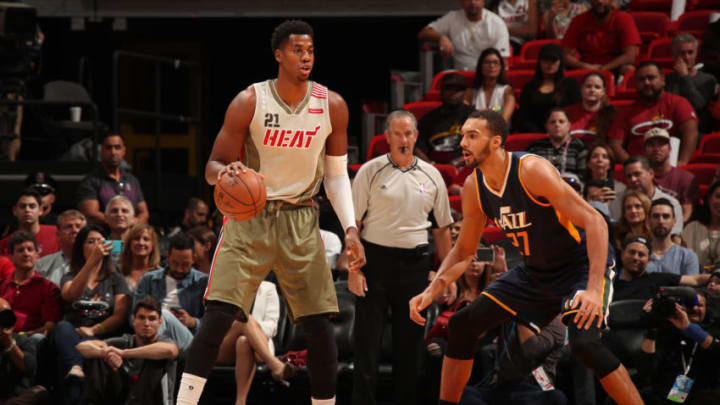Hassan Whiteside should look beyond his Miami Heat colleagues for guidance.
Comparing NBA players is an inexact science at its best.
Trying to evaluate two players introduces so many variables, that arguments usually devolve into mindless rambling.
Take the Michael Jordan–LeBron James debate. Neither side has a flawless argument. Sure, one of these guys won six titles in six tries, but he did so during a career that came with not one, not two, but three retirements.
At the peak of one’s craft, as some 400 active NBA players are, comparisons are less important than inspiration. Recently, drafted rookie Mo Bamba had such a mentality, joining the ranks of countless players past who admit that they draw inspiration (or flat out steal) from their colleagues.
"“Although there’s no one I really pattern my game after, I am a firm believer in stealing stuff from other people,” Bamba told ESPN in June."
Learning from and implementing the work of others is both a huge complement and sign of mental aptitude. Few successful individuals, basketball or otherwise, have completely reinvented the wheel.
Even the Monstars from cult classic/legitimately amazing film Space Jam resorted to robbing existing players of their hooping skills.
For the Miami Heat, this mentality has to fall onto one player in particular: Hassan Whiteside. He needs to use Rudy Gobert as inspiration.
Petty theft
Basketball thievery has a home in South Beach. Dwyane Wade, arguably the third best shooting guard of all time, pattered his undersized block game after Jordan.
And, in something of a basketball version of six degrees of separation, Dion Waiters modeled his game after Wade, bestowing upon himself the moniker “Kobe Wade”.
In Whiteside’s case, modeling his game after Gobert will require some immense pride swallowing.
The 7-footer has made clear he’s willing to clap back at anyone with whom he disagrees.
During the 2017 offseason, Whiteside engaged Gobert in a microscopic Twitter beef as Miami was courting Gordon Hayward. Gobert, wanting his then-teammate to re-sign in Utah, called into question the Heat and Boston Celtics organizations with a series of… emojis.
🌴🗑☘️💩🎷🏆
— Rudy Gobert (@rudygobert27) July 2, 2017
To which Whiteside responded with his own set of electronic hieroglyphs that he promptly deleted.
Thankfully, I’ve painstakingly recreated his message below:
"“Between 2000 and 2017, Mr. Gobert, the Miami Heat have produced more championships than the Celtics and Jazz combined. Good day, sir, good day.” – Whiteside, July 2, 2017."
Though he’d never admit that Gobert could serve as a point of inspiration, Whiteside should look to him for guidance. A pair of 7-foot tall behemoths, Whiteside and Gobert were both on the wrong side of injury, playing just 54 and 56 games, respectively.
Gobert however, manages to reintroduce himself into the Jazz’s rotation in a way that Whiteside never could.
Despite both players serving as defensive anchors and glass cleaners for their respective clubs, Gobert has had a better go at reintegration.
The secret?
He doesn’t focus on his shortcomings.
Great Wall of Gobert
Like Whiteside, Rudy Gobert made his name as a ruthless shot denier and advocate of the defensive rebound. But his value runs deeper than box score tracking.
In his 56 games last season, Gobert led the Association in screen assists, averaging a hair over six per game. Subsequently, Gobert’s fleetfooted nature has helped rookie Donovan Mitchell to unlock his offensive game at the professional level.
Mitchell, a natural-born slasher, benefits from Gobert’s willingness to set screens high and early. Even though Gobert is not a threat from deep, meeting Mitchell at his convenience allows for misdirection and open lanes.
By generally becoming a nuisance, Gobert gives Mitchell, and Ricky Rubio for that matter, offensive options.
Here, Gobert sets a handful of moving screens. Entirely illegal, the referees miss the call and Gobert effectively ushers Mitchell to the hoop.
The success Gobert sees as a screener isn’t just because he sets (usually) good screens. Nor is it the fact that he’ll chase his teammates’ defenders to the ends of the court for the perfect set up.
Rather, Gobert’s on-court mentality aligns himself with sacrificing stuffing his own stat sheets for the good of the team.
Miami has similar pick-and-roll options as Utah.
Josh Richardson can manage a few dribbles to assault the rim, and Goran Dragic has proven fearless attacking the hoop.
But without imposing screens, their effectiveness is diminished. Last season, Whiteside averaged half as many screen assists, many of which were low-effort and disengaged.
Dragic manages to finish the bucket, but Whiteside’s pick was completely ineffectual, allowing Ish Smith the chance to tailgate him to the rim.
When Whiteside mentally checks out, it’s usually because his shots aren’t falling. His absentmindedness hurts more than his own offense though, as his rebounding, shot contesting and general effort suffers as well.
Head coach Erik Spoelstra recognizes the power of a motivated Whiteside.
"“It’s all about consistency night in, night out,” Spoelstra said of Whiteside after a January win. “On both ends of the court, we felt him. The offensive rebounding. Those were extra possessions. Those were multiple effort plays to get the ball. There were several of them that you didn’t didn’t think he had a chance to get to…. It’s that kind of mentality. We have to build on that.”"
Following the Gobert model would see Whiteside transform himself into the most productive version of himself. Instead of defining himself by how many shots he snatches out of the air or lobs he finishes, making sure his teammates succeed would unlock Whiteside’s highest potential.
At this point of his career, Whiteside shouldn’t need any more motivation.
He’s been clowned repeatedly by Joel Embiid, been tossed around in trade rumors and been benched in the playoffs. But unless he gets traded, Whiteside still has time to show Miami he can work.
Two years and $50 million worth of time, that can help define the Heat’s direction moving forward.
